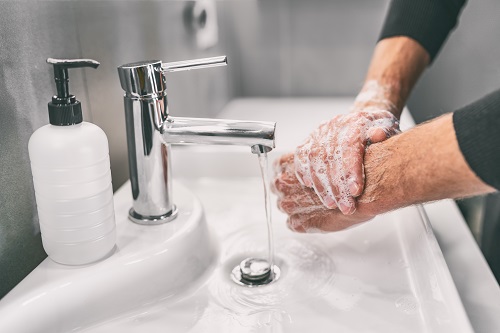We’re all being inundated with coronavirus disease 2019 (COVID-19) information, tips and news, everywhere we look. But despite all the information coming from reputable sources like the Centers for Disease Control and Prevention (CDC) and the World Health Organization, there are still many misconceptions, or myths, floating around about the transmission of COVID-19.
“With the endless supply of information available about COVID-19, it can be hard to decipher fact from fiction. In this uncertain and fluid time, it is more important than ever to obtain information from a reputable source, such as the CDC and Banner Health, to ensure your safety and reduce your potential for contracting the disease,” said Marjorie Bessel, MD, the chief clinical officer at Banner Health.
Let’s explore some of the myths you may have heard about how the virus is transmitted.
Myth: Coronavirus can stay alive on hard surfaces for 2-3 hours at most.
Fact: The length of time coronavirus stays live depends on the surface. According to a recent study published in the New England Journal of Medicine, the virus that causes COVID-19 is detectable in the air for up to three hours, up to 24 hours on cardboard and up to 2-3 days on plastic and stainless steel. While this may sound alarming, the amount of live virus remaining on the surface after this period of time is very small. The best way to protect yourself is to continue to clean and disinfect surfaces that many people come in contact with. These include tables, doorknobs, light switches, countertops, handles, desks, phones, keyboards, toilets, faucets, and sinks. Avoid touching high-contact surfaces in public.
Myth: You should not share a washing machine with a coronavirus-infected person.
Fact: You can use a washing machine that has cleaned an infected person’s clothes. The CDC says you can wash an infected person’s clothes with those of someone not ill, and advises using your regular laundry detergent and then drying the items thoroughly in the warmest temperatures recommended on the clothing label. For added safety, the CDC recommends wearing disposable gloves, keeping dirty garments away from your body, and washing your hands immediately after removing your gloves. Clean and disinfect clothing hampers using an EPA-registered household disinfectant.
Myth: You can contract COVID-19 from a piece of mail or delivered package.
Fact: The World Health Organization dispelled this myth, saying “the likelihood of an infected person contaminating commercial goods is low, and the risk of catching the virus that causes COVID-19 from a package that has been moved, travelled, and exposed to different conditions and temperatures is also low.” Before a package arrives at your doorstep, it has been exposed to various temperatures that the coronavirus is unlikely to survive.
Myth: I can contract COVID-19 from the grocery store employee who rang up my order without wearing gloves.
Fact: According to the CDC, there is no current evidence of food or food packaging being associated with the transmission of COVID-19. However, because the virus can live on surfaces for hours or days, the CDC recommends following their standard steps for food safety – wash your hands with soap and water before handling food, rinse produce under running water before eating, and scrub produce with a produce brush. For packaged foods, consider cleaning the outside of the packaging with disinfectant.
Myth: Homemade disinfectant doesn’t work as well as store-bought in fighting against COVID-19.
Fact: If you use the correct base, like bleach – not vinegar, as it is not strong enough – your homemade disinfectant is just as effective as the store-bought kind. According to the CDC, a combination of 1/3rd cup of non-expired bleach with one gallon of water can effectively disinfect surfaces against the coronavirus. Important safety notes when working with bleach: always wear gloves and never mix bleach with vinegar, ammonia, isopropyl alcohol or another household cleaner. Additionally, alcohol containing disinfectant solutions may be used- they need to have 70% alcohol.
All of these tips are helpful in trying to keep you and your family healthy and safe from COVID-19. But remember, one of the most effective ways to ward off germs and viruses is to wash your hands often and properly. “Diligent hand hygiene will always be one of the most important defenses all of us have to reduce the risk of catching all types of infection and becoming ill,” said Helen Arnold, RN, an infection prevention specialist at Banner Desert Medical Center and Banner Children’s at Cardon Children’s Medical Center. “This is true whether we are in a hospital or community setting.”
For more information on COVID-19 and how you can stay well, visit BannerHealth.com.




